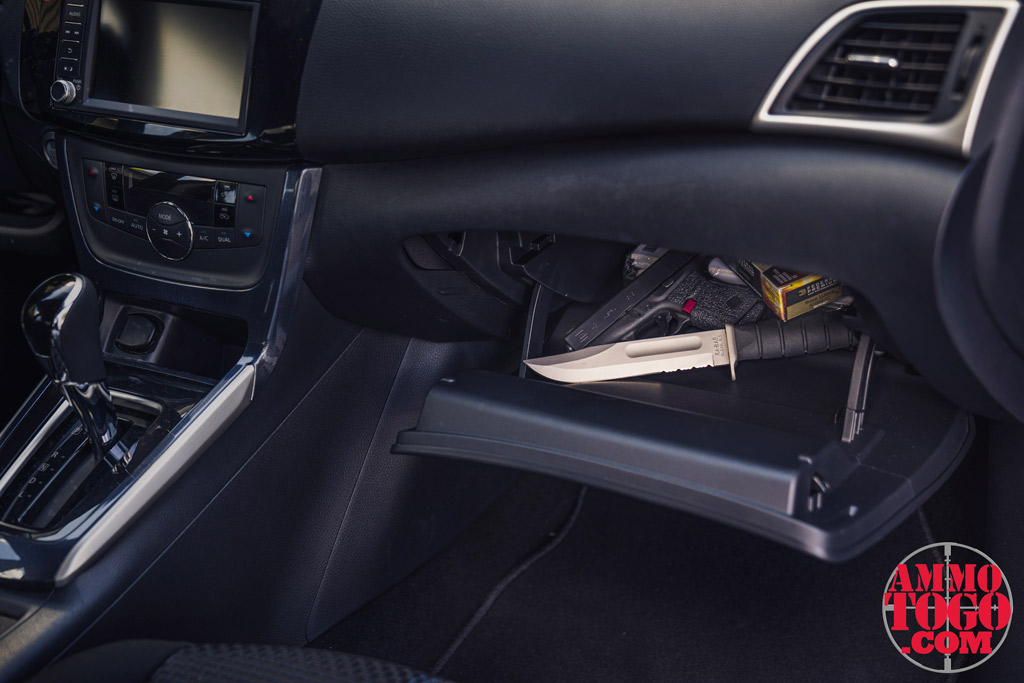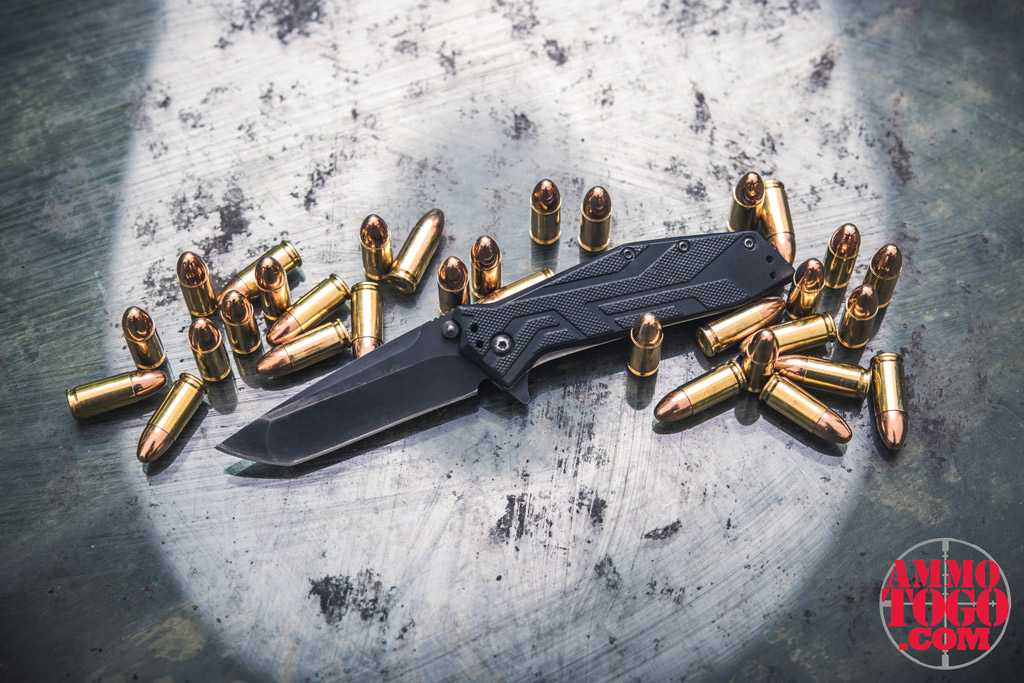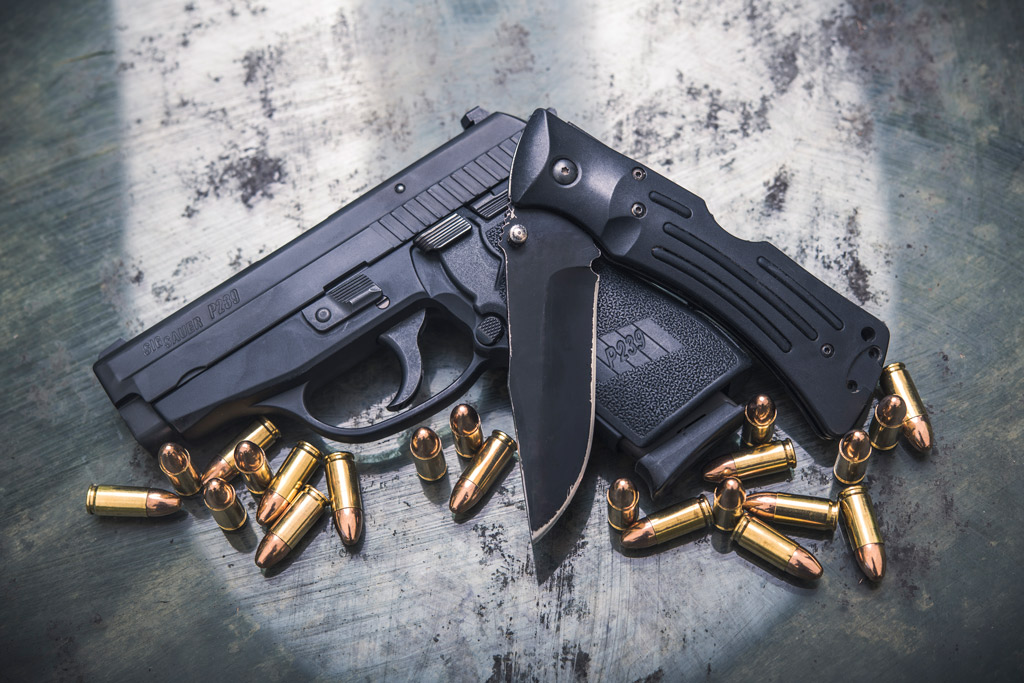A quick guide to gun laws vs. knife laws in the United States. This article explores how knife and gun restrictions differ and the many ways they are similarly regulated with intense complication based on the city and state you live.
Do you know the knife laws in your area?
Is a hunting knife stored in your glove compartment considered a concealed weapon?
Is carrying a handy pocket knife as you walk down the street a potential offense?
Understanding knife laws in your area is essential, so you need to be informed and knowledgeable. As you’ll find, knife laws share many similarities with gun laws even if gun laws tend to get the majority of the media’s spotlight.
Similarities Between Gun Laws and Knife Laws
Gun laws and knife laws, while different, have many similarities. Basic principles of concealment, ownership, and sales apply, and you have to know the law in order to stay legal. In the way that gun owners often roll their eyes when a state passes a law on magazine capacity, knife owners are perplexed when a state puts a blade length restriction on the books.
It’s clear, whether carrying a knife or gun for self-defense or simply carrying a pocket knife in case you need to cut an apple while waiting at the doctor’s office, you need to know what you can carry and where it can be carried or be prepared for legal consequences.
Lobbying Horsepower – Guns vs. Knives
Given the number of anti-gun Americans who criticize pro-2nd Amendment politicians as being in the “pocket of the NRA”, it seems a look at what the industries spend on lobbying efforts is relevant. If you consider dollars spent a barometer of power, the knife industry is… well, bringing a knife to a gun fight when you see what they spend relative to the firearms industry.
Benchmade Knife Company spent an average of $96,018 each year from 2014 to 2018, according to the Center for Responsive Politics. During that same time period, Smith & Wesson spent an average of $102,000. Vista Outdoors spent $425,000 on average from 2015 to 2018.
The American Knife & Tool Institute spent an average of $80,000 each year during that same period. The National Rifle Association spent $3.89 million to protect our constitutionally granted freedoms.
Federal Laws Apply, But Generally Governed by State
Like firearms, knife laws are largely decided by the state, which complicates the matter when a knife owner carries or transports knives across state lines.
Like gun laws, federal law applies too, and it “preempts,” (see “preemption” under terminology section) or overrides, state and local laws if those lower laws contradict the federal.
An example of federal preemption in firearms regulation is a ban on fully automatic weapons. This law applies to everywhere in America, so a government in, say, Pennsylvania can’t create a law that makes fully-automatic weapons legal, as it would directly contradict the federal law.
In knife law, an example of preemption would be a federal ban on ballistic knives, which eject the blade with a forceful and dangerous velocity. Once again, this federal code cannot be overridden by a lower government.
With gun and knife laws, you have to abide by the rules of both the federal government and the state government, but you will also have to abide by the laws of local cities and municipalities, which often pass their own restrictions on knives.
Concealed and Open Carry Applies to Knifes as Well as Guns

When you hear the term “concealed carry,” you probably think of firearms; specifically handguns. However, this term also applies at the legal level to knives, and once again you have to navigate the tricky waters of state laws and vague terminology to determine what is “concealed,” and what isn’t.
The issue of a weapon in a vehicle comes up frequently in the discussion of concealment. Generally, if it is within reach of the driver, it can be considered a concealed weapon. So, for example, if you were to place a hunting knife in your truck’s center console, it could be legally classified as concealing a weapon, which means you may run afoul of the law if concealing that weapon is illegal or you are not properly authorized to conceal the weapon.
However, if you store the hunting knife in a truck-bed toolbox, it’s out of reach and would not be concealed. In this case, it would legally be classified as transporting the knife, not concealing. In this example, you could swap out the hunting knife for a handgun and the same principle would apply: in the center console, it’s possibly a concealed weapon according to law, while in the trunk it is simply being transported.
Flying with Guns and Knives
We’ve talked about driving with firearms, but what if you are actually flying across the country? In this case, the laws for guns and knives have differences, but the overarching laws are pretty much the same.
For painfully obvious reasons, both knives and firearms are not allowed on your person or in your carry-on bag. If you want to transport a firearm and some .308 ammo across the country, say for a hunting expedition, you need to pack your weapon in a hard-sided case that is lockable. The weapon must be completely unloaded, and you have to remove magazines. You’ll also have to fill out a declaration card, an important step for transporting and reclaiming your weapon.
For knives, you simply have to pack the knife into a checked bag. There are no restrictions on size and type, but you do have to ensure that the knife is properly sheathed and protected against potentially piercing the luggage and harming a baggage worker.
Can I Carry a Pocketknife on a Plane?
In 2013, there was a proposal by the Transportation Security Administration to allow small pocketknives to be carried on airplanes. However, there was significant backlash from a wide variety of groups, including flight attendant associations who had concerns about the safety and security of both passengers and employees. There was significant news coverage on TSA’s proposed changes, but the decision to keep knives banned from flights received far less attention, leading some people to think that TSA proceeded with the change. However, the TSA’s website makes it perfectly clear: pocketknives cannot be carried by passengers onto the plane.
Folding Knives vs Switchblades: An Essential Legal Distinction

One of the most significant legal issues for knives involves switchblades. While we mentioned them in the terminology section, it’s essential that all knife owners, and especially those who want to carry knives, understand the difference between a folding knife and a switchblade, as these two products are regulated in vastly different ways.
Folding knife is a term used to define a knife that folds in the center, and it can include switchblades and assisted-opening knifes. Generally, however, a folding knife is used to describe a pocketknife that folds and opens without any assisting mechanism or additional force; you have to open and close the knife entirely with your own effort, usually using two hands: one to hold the handle and the other to move the blade. There are no buttons that release the blade automatically, and not springs that eject the blade with force. There is far less concern, and hence fewer legal restrictions, on owning and carrying folding knives, especially those that feature a small blade.
Switchblades, on the other hand, are highly regulated, not only by state and local laws, but by the federal government. These are knives that allow the blade to be exposed with the simply push of a button or release of a lever. The blade, which is activated by a spring, can extend straight forward from the inside of the handle or can be released from a folded position. Many states have regulations on record that make it illegal to carry and even own a switchblade, so be hyper aware of the legalities of ownership if you purchase or own any blade that is released with the simple push of a button.
What About “Assisted Opening?”
Another term that you need to clearly understand, as it is considered under legal terms as a different type of knife, if “assisted opening.” This basically applies to any folding knife that requires manual opening of the knife but finishes or eases the opening process with a mechanical mechanism. Users of these knives need to apply pressure with a thumb to start the opening process, but once this is started, the blade uses tension or a spring to quickly complete the opening. One of the main features is that they allow a user to open the knife with only one hand. They are not legally classified as switchblade because the user does not push a button, but in many areas they are treated with the same legal restrictions.
At What Length is a Blade a “Dangerous Weapon” According to Law?
When it comes to knife length, size is also an important consideration. According to the American Knife & Tool Institute, which has compiled information on state knife laws, many states have enacted dimensions that help regulate what knives can be carried in public and which can’t.
In Iowa and North Dakota, for example, anything over five inches is considered a dangerous weapon, while Nebraska and Colorado set restrictions if a knife is 3.5 inches or larger. In New York City, there is an ordinance restricting the concealment and carry of any knife over four inches, while in Texas, a blade over 5.5 inches is a restricted knife.
The lesson is that no matter where you live or travel, you need to know the restrictions on blade length so you stay within the confines of the law.
The Switchblade Act of 1958
Anyone who researches knife laws will inevitable come across The Switchblade Act of 1954, which defined restrictions on switchblades and determined how the federal government controls knives for many years.
The act was actually inspired by Hollywood movies portraying young adults wielding switchblades for violent purpose. Films like Rebel Without a Cause showed troubled teenagers using knives for personal protection and aggression, triggering what is now often seen as paranoia against these items, paranoia that led to legal restrictions on these knives.
This act prohibited the production and sale of switchblade knives in interstate commerce. While it did not specifically make switchblade illegal, it did make it illegal to manufacture these products and sell them across state lines, although people could still sell the weapons in the same state.
In most areas, this law has no impact on the possession of switchblades, nor did it actually make carrying them illegal. What it did was to establish, or at least institutionalize, was a general fear or mistrust of switchblades. It did not change anything for people who own them, but it set the table for many states to make switchblade possession or carrying illegal. Numerous states now make it illegal to carry a switchblade, butterfly knife, or assisted-opening knife, and many of these laws are seen as a direct progression of the Switchblade Act of 1958.
Issues with Knife Laws: Vagaries of Definition
An issue that all knife owners should be aware of is the vagueness of definitions when it comes to knives and sharp weapons, as these vagaries can make ownership more difficult, and at the very least make it hard for owners to understand whether carrying a certain knife is legal or not.
For example, a “dagger” and a “stiletto” are two highly similar knives, and one could argue that stilettos are simply a type of dagger. So if a state law says it’s illegal to carry a dagger, does that include stilettos as well?
In states that outlaw carrying certain types of knifes, the definitions are often loose and left to interpretation. Staying with the dagger example, it can be hard to know what is considered a dagger and what would not be a dagger. Like firearms laws, it’s up to the owner and user to fully understand the law in your area.
So, Where Are You Likely Not Able Carry a Knife?
If you carry a pocketknife for general purposes, you need to be aware that there are a few places where you should completely refrain from carrying the tool.
Most of these are obvious: schools, libraries, court houses, and other government building are highly sensitive about people bringing in anything that could be considered a dangerous weapon. The same goes for sporting events, as they usually have a ban on knives, even small folding knives.
You may not feel that your small pocketknife even remotely constitutes a dangerous weapon, but, to be blunt, what you think constitutes a weapon doesn’t matter. What does matter is how the leaders of the community or facility classify weapons, and they often have a broad definition of dangerous weapons.
As a responsible citizen, it’s up to you to understand the laws. When in doubt, it’s a good idea to not carry your knife, no matter how small, into building and facilities that clearly prohibits weapons. We may not like it but “their house, their rules.”
A Knife to Carry (Almost) Anywhere?
Most of us who carry a knife probably fit into one of two buckets. The first, and likely the most common, is simple utility. Many people like to have a knife that they can carry almost anywhere and keep in their pocket without accidentally running afoul of the law. Is there such a knife?
The absolute answer is no, there is no knife you can carry anywhere, just as there’s no gun you can carry anywhere. However, if you simply want a knife for opening boxes, cutting paper, and slicing packages, your best option is to go small and choose a product that requires two hands to open. No, this may not be the most exciting or interesting option, but if your goal is utility, a knife like this can be carried in more places without making you an accidental criminal.
Guns and Knives: Understand the Local, State, and Federal Laws

The most important aspect of laws applying to both knives and firearms is that you must understand the laws where you live and where you travel. For example, if you have a concealed-carry license in Iowa and you carry your weapon in your car tucked in a hidden holster where it can be accessed from the driver’s seat, you must unload and store the weapon out of reach if you travel into Illinois, as their laws are much more strict when it comes to firearms. Likewise, if you live in Wyoming and always carry a handy five-inch folding knife in your back pocket, you can’t legally do the same in Colorado, as the states have differing laws.
Differences also apply to cities, but the most important and consistent changes occur and the state level, so always be aware of state law, especially if you are traveling from state to state.
All gun owners and knife owners should understand that ignorance of the law is no defense. With that in mind, you are responsible for researching the regulations in your area and doing whatever you can to stay safe and legal.
Knife Law 101: Understanding the Terminology
Assisted-Opening Knife: A type of folding knife that doesn’t open completely on its own, but once opening has been activated is able to assist with a spring or another form or mechanism.
Balisong Knife: Also known as a “butterfly knife,” this is a knife with handles that rotate around the knife to either cover the blade or expose the blade. They are illegal to carry in many states and often illegal to manufacture or sell.
Ballistic Knife: A knife with a detachable blade that can be ejected with force and launched for a distance up to a few yards. Often spring powered, these knives are largely illegal to carry and in some cases are restricted by ownership laws.
Bowie Knife: A long, wide fixed-blade knife that is double-edged at the point and has a large hilt. These are also illegal for carry, both open and concealed, in many states.
Concealed Carry: Carrying a weapon, generally a gun but also including knifes and other weapons, in a manner that it is generally available to the person yet hidden from sight by an observer. Having a knife or firearm under your clothing is obviously defined as concealed carry, but it can also include a backpack, depending on the situation. However, (and this is where things can be complicated) depending on the local and state laws, a firearm or knife in a case, not a holster or sheath, could be considered concealed carrying, not transporting.
For driving, most laws state that if a handgun is within reach, it is considered concealed carry, so just about the only way for you to be completely clear of being considered, legally speaking, of carrying the weapon, it would need to be in the trunk or absolutely far enough to be out of reach of the driver.
Dagger: A fixed-blade knife that has cutting edges on both sides and a narrow tip. Generally intended for stabbing, these knives are often limited for carrying purposes in many states.
Dirk: A loosely-defined type of dagger that is mentioned in many state laws. Often illegal to conceal carry, although exactly what constitutes a dirk is not entirely defined.
Disguised Knife: A knife that is disguised to look like a different item, often with a cover concealing a hidden blade. Notable products include knifes manufactured to look like pens, combs, and lipsticks cases.
Ownership Law: This is essentially a law that states it is illegal to own something, meaning you can’t even have it in your home. A good example of this would be fully-automatic weapons and ballistic knifes, which are largely illegal to own and posses in the United States.
Preemption: The legal principle stating that if laws conflict, the law of the higher authority will be used. Preemption means that if a local law conflicts with a state law, the state law is used. Likewise, if a state law is in direct conflict with a federal law, the federal law remains. State preemption is an important and hotly-debated topic in both knife and gun law, as it generally restricts local municipalities from enacting laws that conflict with, or are decidedly more severe than, state laws. Generally, people who feel cities should be able to define knife and gun laws are opponents of state preemption, and people who feel states should define the laws are opposed to federal preemption.
Fixed-Blade Knife: A knife that has a handle and blade permanently fixed into place. The knifes in your kitchen are fixed-blade knifes, as are dirks, daggers, and bowie knives, which have no folding mechanism.
Folding Knife: A knife with a blade that can fold into the handle and has no spring or push-button mechanism to extend the blade. This terms includes basic pocketknives that require you to pull the blade out, generally using both hands; one to hold the handle and the other to pull the blade.
Switchblade Knife: While the definition is always changing, as manufacturers try to skirt the law with just-barely-legal designs, these are essentially knives that have blades that can be hidden in the handle and opened automatically, usually either by the push of a button, but it can also include the operation of inertia.
Stiletto: A dagger of Italian origin with a narrow, needle-like blade. Designed for deep stabbing, these knives are illegal in many state laws.




